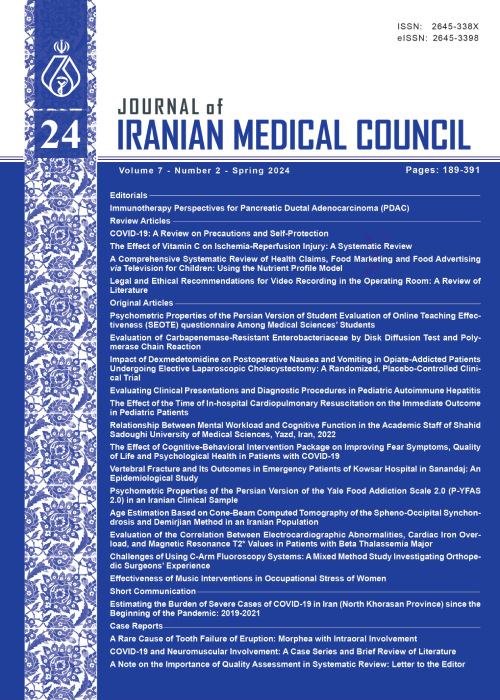Impact of Chronic Hypoxia on Neurodevelopment of Children with Cyanotic Congenital Heart Disease
Author(s):
Article Type:
Research/Original Article (دارای رتبه معتبر)
Abstract:
Background
Children with cyanotic Congenital Heart Disease (CHD) are at higher risk for delay in their growth and development due to more energy consumption during their activities. In addition, they are more prone to respiratory infection and hospitalization. Due to the nature of disease, these patients suffer from a chronic hypoxia and its impact on growth and development is not well investigated. This study was designed to find out which physical growth and neurodevelopmental parameters of these patients are affected by chronic hypoxia in comparison with acyanotic disease. Methods
81 children with CHD (34 cyanotic and 47 acyanotic), aged between 6 months to 3 years from Children’s Medical Center affiliated to Tehran University of Medical Sciences in Tehran were recruited from January 2013 to January 2014. Growth parameters including weight, height, and head circumference were checked and then these indices were categorized into three groups of Failure To Thrive (FTT). Functional development was assessed by using modified Denver Developmental Screening Test (DDST II). Results
In acyanotic group, Ventricular Septal Defect (VSD) and in the cyanotic group, tetralogy of fallot (TOF) were the most prevalent disorders. Growth indices were low in 52% of patients (70% of cyanotic and 38.2% acyanotic), and also weight and height parameters were significantly lower in the cyanotic group (p= 0.009 and p= 0.05). 62% of cyanotic patients and 17% of acyanotic patients had delay at least in one of their neurological development indices (Gross motor, fine motor, speech or psychosocial behavior). This study also demonstrates an association between neurodevelopment delay and FTT in cyanotic patients, but not in acyanotic ones. Conclusion
Results in this study suggest that children with cyanotic CHD are more prone to delay in their development besides their growth possibly due to the nature of their disease. Therefore, chronic hypoxia can be a risk factor influencing neurodevelopment of the patients and appropriate intervention is required to gain better outcome.Keywords:
Language:
English
Published:
Journal of Iranian Medical Council, Volume:2 Issue: 4, Spring 2019
Pages:
86 to 91
https://magiran.com/p2123524
دانلود و مطالعه متن این مقاله با یکی از روشهای زیر امکان پذیر است:
اشتراک شخصی
با عضویت و پرداخت آنلاین حق اشتراک یکساله به مبلغ 1,390,000ريال میتوانید 70 عنوان مطلب دانلود کنید!
اشتراک سازمانی
به کتابخانه دانشگاه یا محل کار خود پیشنهاد کنید تا اشتراک سازمانی این پایگاه را برای دسترسی نامحدود همه کاربران به متن مطالب تهیه نمایند!
توجه!
- حق عضویت دریافتی صرف حمایت از نشریات عضو و نگهداری، تکمیل و توسعه مگیران میشود.
- پرداخت حق اشتراک و دانلود مقالات اجازه بازنشر آن در سایر رسانههای چاپی و دیجیتال را به کاربر نمیدهد.
In order to view content subscription is required
Personal subscription
Subscribe magiran.com for 70 € euros via PayPal and download 70 articles during a year.
Organization subscription
Please contact us to subscribe your university or library for unlimited access!


